Guest Editorial: Going With the Foe
By Clark Tibbets
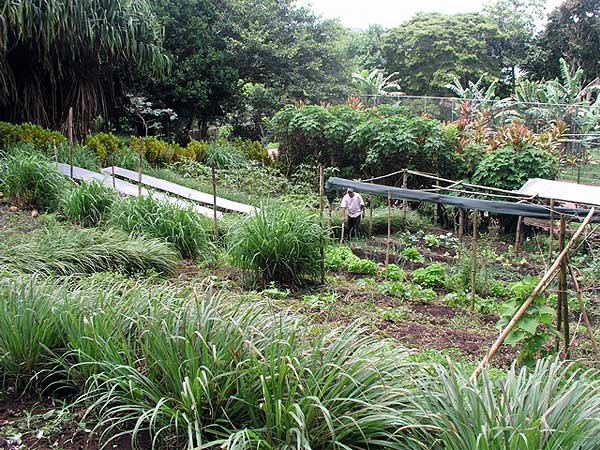
It's a cool and sunny fall afternoon, three weeks after the first frost. I am just in from the garden with smudged knees, warm back, basket brimming with perfect ripe red raspberries, and a lesson for living in the hip pocket where I usually keep my wallet.
The Beetle Battle
Japanese beetles have been my number one garden foe ever since the import quotas were relaxed. I squeezed them between my fingers in the beginning until the stain would no longer wash away. Then I turned to the neater and--I told my son--more humane trick of gently nudging them off the leaves into a cup partly filled with water. I soon switched to gasoline in the cup for a quicker kill.
I made my daily round of the long raspberry row in the dewy morning when sleepy beetles were slow to fly. I wanted to be sure of getting them all--of course, I didn't. By midsummer they were usually stacked two and three deep on the tips of the canes and I often had to add a dusk patrol to keep up with them.
After a few years of this, it occurred to me that it would be cheaper, not counting my time, to enlist bacterial agents in this battle--the price of gasoline had been going up. So, I invested thirty-some dollars in a treatment for the grass around the row. If those pricey germs did any good, I couldn't see it. I continued with cup in hand while waiting through two seasons for the infection to spread. There seemed to be as many beetles as ever.
Foiled Again
Last summer, after seeing no light at the end of the tunnel, I gave up. I tried to avoid looking at that part of the garden, but when I did mistake a glance, I saw them massed on the leaves like spots on dominoes. I worried about which of my prized vegetable plots they would take over next. After the frost, I forgot about them.
I almost forgot about the raspberries, too, until today, when I noticed clusters of red jewels sparkling in the sunshine. It is a great crop, with the heavy canes bowed over to the ground. I had assumed that the beetles took lunch breaks between their long sessions of lovemaking and that they ate with the same vigor as they copulated. Not so! There are some shredded leaves, but the plants are healthy and their yields unyielding.
We Have Met the Enemy . . . .
Why am I so surprised? I have learned this lesson before. I am remembering the time eight years ago that I first saw rat holes in my compost pile. Even my neighbors were worried then. I didn't know what to do, so I decided to do nothing until I might be confronted with evidence that they were doing some harm to the garden or invading the house.
Over the following years, I rarely saw a rat beyond the shadow of the pile. Sometimes a pink nose and squinty eyes would peek out from a hole and look me over as I tossed them their dinner. About the only time they came out was when it rained. Maybe their scents didn't carry then and they felt safer. Anyway, they didn't seem to have any purpose in coming out other than perhaps to be rinsed off.
I actually enjoyed their rainy day frolics and appreciated the work they were doing for me by digesting food scraps, adding manure and aerating the compost. Rats, like bears and some other mammals, must have some way to regulate reproduction to match the available food supply, because they have never overflowed my single large pile.
I use a cool composting technique with just one turning of the pile after two or three months. When it is turning time, I do the top half and then wait a week or two to give the rats time to move over into the new pile where the fresh food scraps are placed. Finally, I turn the rest of the old pile to the top of the new one. Each time, I open up a maze of tunnels but have never poked a rat with my fork.
I hope I never do.
Reprinted from The Friendly Vegetarian, Summer 1994
Subtitles Added
Note: Agribusiness giants. who have many acres planted in the same crop, often on degraded soil, find that plant-eating insects multiply out of control. Most owners then reach for poisons, thus endangering farm workers, consumers, and the planet. The proliferation of the beetles is limited in Friend Clark's garden because bordering his raspberries are other kinds of plants not susceptible to the beetles, and because his soil is rich and his plants vital and healthy. He follows nature's way.
News Notes
Favorable Changes in the WIC Program
The Women, Infants and Children program (WIC) has been revised to better meet the nutritional needs of the 8.5 million people it serves. The USDA announced that tofu and soy beverages, along with fruits, vegetables and whole grains have been added, while the amounts of milk, cheese, and eggs it permits have been reduced. The changes were based on suggestions made by the Institute of Medicine. To read the full article, see www.foxnews.com/ wires/ 2007Dec06/ 0,4670,DietWICFoods,00.html
--Contributed by Lorena Mucke
Christian Vegetarian Association, www.christianveg.com
More News from Newsweek
In Newsweek, December 17, 2007, the "Periscope" section on page 14 (at least in our local edition), has an article , "Vegetarian Convictions," about vegetarian meals being made available for prison inmates. At least one person has objected: "Why should prisoners eat healthier than the general population?" Why? Because it costs no more, and in the long run will save the taxpayer money, since expenses for the treatment for health problems caused by a meat-based diet, such as diabetes, obesity, heart disease, cancer, etc, will be much lower. (However, this benefit is not available in all states; e.g., in Wisconsin, prisoners must have religious or medical authorization to go veg. Go figure . . . .)
- Contributed by Benjamin Urrutia
Chicago, Illinois
Ponies and Small Persons
Nicaragua was prominent in the news twenty years ago as the site of a war in which a United States-funded guerrilla army attempted to destroy the new society being built, and to re-establish economic colonialism. One of the permanent effects of the war was a great increase in the numbers of abandoned and homeless children. A project called "Ponies and Small Persons" will soon be launched to try to reclaim some of these waifs, as well as some of the horses exhausted from a life of vehicle-pulling slavery. Both the street children and the horses have increasingly been driven onto the hard margins of asphalt "progress" by swelling numbers of the SUV's that are destroying our very planet. These human and equine outcasts are to be brought together for mutual healing on a model farm belonging to the Center for the Investigation and Promotion of Rural and Social Economy (CIPRES). In basic social units of three children to three horses, with the care of trained staff, the children will receive regular meals and tender nurturance, in some cases for the first time in their lives, together with education crucial for their future. The horses at last will experience gentleness, rest, and love. Financial contributions are welcomed. See
echoesofsilence.pbwiki.com/ Ponies+and+Small+Persons+Project
--Contributed by Paul Baker Hernandez
Coordinator, Echoes of Silence
Gems
No one can look on God and live--live in his or her own faults, live in the shadow of the least self-deceit, live in harm toward God's least creatures, whether human or bird or beast or creeping thing.
--Thomas Kelly
(Slightly edited)
True human goodness, in all its purity and freedom, can come to the fore only when its recipient has no power. Humanity's true moral test, its fundamental test (which lies deeply buried from view), consists of its attitude towards those who are at its mercy: animals. And in this respect humankind has suffered . . . a debacle so fundamental that all others stem from it.
-Milan Kundera, The Unbearable Lightness of Being
I love all the animals in the world. I don't want to kill the world. I don't want to throw garbage on the world. I care about all the people. . . . I want no people to kill our animals and I love the world. It's beautiful. The trees . . . . make angels with their leaves. They send angels to me to give secret messages. I don't want boats to spill oil. I want people to stop their brakes when they see a bunny. I don't want no people to cut down trees.
--Alexander Dolan, age 5
Any time some people (the "Ins") want to exploit other "inferior" people (the 'Outs'), the Ins will always have two powerful forces on their side: One will be organized religion; the other, the "best" science of the day. Both will say (in their authoritative voices): The Ins really are better than the Outs. Our sacred books say so. So do our esteemed scientists. So what's to complain? The Outs are exactly where they belong. Under the boot of the Ins.
--Tom Regan
Book Review: Sailing with Noah and Life at the Zoo
Bonner, Jeffrey P., Sailing with Noah: Stories from the World of Zoos. Columbia, MO: University of Missouri Press, 2006. 309 pp. $22.50 softcover.
Robinson, Phillip T. Life at the Zoo: Behind the Scenes with the Animal Doctors. New York: Columbia University Press, 2004. 292 pp. $17.95 softcover.
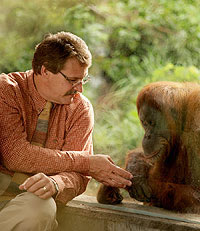 Zookeepers have a peculiar role in the world of animal concerns. Theirs is a difficult, often thankless job, in which several highly diverse constituencies need to be satisfied, and in which missteps are often loudly publicized in the media by watchdog groups. On the one hand, the best of the zookeepers– among whom the authors of these two books must certainly be counted – are well-trained, motivated by a real love of animals frequently going back to childhood, and dedicated to doing the best they can both for the animals and for the educational and ecological roles they envision for zoos, in which they deeply believe. On the other hand, they are aware that a zoo environment, however well planned, can never be truly natural for the animals, and that they are subjecting them to stress and, too often, unnatural danger of disease or injury.
Zookeepers have a peculiar role in the world of animal concerns. Theirs is a difficult, often thankless job, in which several highly diverse constituencies need to be satisfied, and in which missteps are often loudly publicized in the media by watchdog groups. On the one hand, the best of the zookeepers– among whom the authors of these two books must certainly be counted – are well-trained, motivated by a real love of animals frequently going back to childhood, and dedicated to doing the best they can both for the animals and for the educational and ecological roles they envision for zoos, in which they deeply believe. On the other hand, they are aware that a zoo environment, however well planned, can never be truly natural for the animals, and that they are subjecting them to stress and, too often, unnatural danger of disease or injury.
The two books under review go together, for they are in fact strikingly similar in concept. Both chronicle many years of zoo experience on the part of the authors, in the process relating fascinating anecdotes, some amusing, some poignant, about the animals and the no less strange and interesting people zoos tend to attract as staff and as attendance "regulars." We learn much about planning appropriate environments for different species, feeding, medical care, animal births and infancies, security issues, escapes, programs, and public relations matters. We get heartfelt agonizing from these writers about the cases they have known in which an animal has seriously injured, or even killed, a caretaker, or in which an animal in turn has been callously killed by a zoo visitor who, for example, thought it would be fun to throw a ball down a hippo's gaping mouth.
There is another kind of agonizing over such matters as the chronic underfunding of most zoos by city councils, or whatever governmental agency controls the moneybags; the need to cultivate often-opinionated donors; and responses to attacks (which these authors naturally feel are well-intentioned but ill-informed) by animal-rights groups such as PETA.
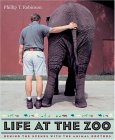 Phillip Robinson was director of veterinary medicine at the world-famous San Diego Zoo for ten years; he is now director of veterinary services at the University of California, San Diego. Understandably, his book gives more attention than the other to animal medical issues. Jeffrey P. Bonner is President (Director) of the also distinguished Saint Louis Zoo. Both are men clearly more used to making practical decisions in real-world situations where options are limited, and none of them perfect, than in dealing with philosophical issues regarding animals rights and welfare. At the same time they each have a vision of an ideal zoo, which, leaving far behind the animals-in-cages model, would provide its exhibits near-natural environments. It would be involved in conservation efforts, especially for endangered species, through maintaining gene pools and in field work around the world; it would make a real difference through its educational efforts.
Phillip Robinson was director of veterinary medicine at the world-famous San Diego Zoo for ten years; he is now director of veterinary services at the University of California, San Diego. Understandably, his book gives more attention than the other to animal medical issues. Jeffrey P. Bonner is President (Director) of the also distinguished Saint Louis Zoo. Both are men clearly more used to making practical decisions in real-world situations where options are limited, and none of them perfect, than in dealing with philosophical issues regarding animals rights and welfare. At the same time they each have a vision of an ideal zoo, which, leaving far behind the animals-in-cages model, would provide its exhibits near-natural environments. It would be involved in conservation efforts, especially for endangered species, through maintaining gene pools and in field work around the world; it would make a real difference through its educational efforts.
These writers are honest enough to recognize that most zoos of the past, and all too many today, fall far short of the ideal. Indeed, as I read these often-horrific accounts, I was about ready to agree with those who say all zoos ought to be closed, despite having greatly enjoyed them in my younger and more naive days. Yet there is always the other side: the millions of children (and adults), especially from our great cities, who would never see an animal beyond dogs, cats, and squirrels, and have no real appreciation of their beauty, character, and way of life, were it not for zoos; the serious efforts of the best zoos today to teach respect for animals, the perilous state of many species in nature, and human responsibility for that situation; the role many zoos are playing in conservation at home and abroad.
Ideally, of course, animals should be in their native setting. Gracia Fay and I had the privilege of seeing them thus as we drove through the wonderful wild-animal parks of South Africa, and the national parks of the United States. But this is not always possible, and it must be borne in mind that the native environment is no paradise for most animals in these desperate times, with rapidly shrinking ranges, appalling poaching, epidemic diseases, and chemical pollution. There is a saying that the best is often the enemy of the good: that in seeking the ideal answer to a problem, we may reject what would be merely a good, or the best available, solution and end up with a situation far worse. These pro-zoo writers naturally believe that very well-planned and well-run zoos can be a part of the good: they can provide animals reasonably happy and secure lives, while significantly contributing to public awareness of the animals', and the world's, perilous state in nature.
Others may differ, holding that the condition of animals in zoos, however good, is still unnatural, is enslavement, and should never be held up for observation or used as a basis for education. You decide. But to get the whole picture first, read books like these as well as those which present another point of view.
--Robert Ellwood
Film Review: Enchanted
Enchanted. A Disney film. Directed by Kevin Lima. Starring Amy Adams as Princess Giselle, James Marsden as Prince Edward, Patrick Dempsey as Robert Philip, and Susan Sarandon as Queen Narissa. 2007.
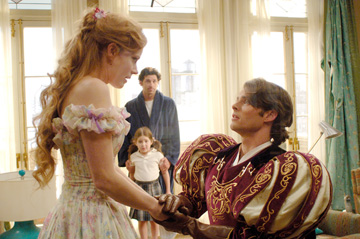
This delightful and funny movie begins and ends in animation, with scenes of the heroine Princess Giselle's friendship with animals - deer, rabbits, skunks, chipmunks. Giselle is a combination of Snow White and Sleeping Beauty, with extended light-hearted borrowings from the 1937 and 1958 Disney movies--though this heroine is considerably tougher than the two others put together. When she is threatened by an ogre, handsome Prince Edward rides forth on a white horse and rescues her. Instantly falling in love, they become engaged.
Between the opening and closing animated sequences, Giselle finds herself exiled by the malice of the prince's wicked stepmother Narissa to our world: specifically, to live-action New York City, where "there is no happily-ever-after." To repay the hospitality of the kind family (Robert Philip and his little daughter Morgan) who take her in, Giselle decides early the next morning to clean up the chaos in their apartment, and summons local animals to help in the task. Cute forest-dwellers being in short supply in New York, it is "vermin"--pigeons, rats and roaches--who swarm in. She is taken aback - for a second. Then she decides it is good to make new friends, and via a Disneyesque song, inspires the urban critters to the task. When Robert wakes up and sees his apartment swarming with creeping things, without knowing what they have been doing for him he gets panicky and shoos them out--perhaps giving child viewers, amid laughs, a sense of the value of the lowest creatures, and the prejudice and ingratitude of ordinary, well-meaning grownups.
(I am fond of pigeons - beautiful and intelligent birds - but less so of rats, and not at all of roaches. I know that God loves them all, and when I see Giselle loving them, I realize how much I fall short of sainthood. I won't be be walking on water any time soon, but it is good to be reminded!)
The only animated animal-friend from the beginning sequence who follows Giselle into exile is the chipmunk Pip. Here he becomes a semi-realistic computer-generated figure, manifestly still able to think, but unfortunately no longer capable of speech. He still manages to save her twice from the plots of the wicked stepmother, considerably outshining the vain and inept Prince Edward in that department. As an animal who manifestly has thoughts and purposes, Pip might influence children in the direction of increased respect for animals; to adults, he will probably only be another in a long line of comic animated animal-sidekicks.
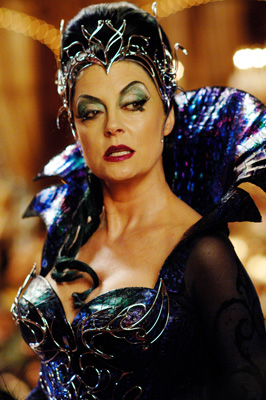 The only other noteworthy animal figure is the computer-generated blue dragon into which Queen Narissa transforms herself, to be finally defeated by Giselle, who rescues Robert from her (literal) clutches. It is hard to speculate what effect this manifestly evil beast will have on children's attitudes toward animals. The positive effect of Pip and the clean-up crew might be undercut by an increased fear of large snakes; both effects might co-exist; or, more likely, the dragon will be too exotic to affect most children's feelings about animals at all.
The only other noteworthy animal figure is the computer-generated blue dragon into which Queen Narissa transforms herself, to be finally defeated by Giselle, who rescues Robert from her (literal) clutches. It is hard to speculate what effect this manifestly evil beast will have on children's attitudes toward animals. The positive effect of Pip and the clean-up crew might be undercut by an increased fear of large snakes; both effects might co-exist; or, more likely, the dragon will be too exotic to affect most children's feelings about animals at all.
Apart from the animal theme, the film convincingly communicates that the hard head and the starry eye need one another. In the process it offers a liberal dose of that best remedy, laughter.
--Gracia Fay Ellwood and Benjamin Urrutia
Recipes
Carrot-Tropical-Fruit Cake
Makes one 13 inch x 9 inch cake
 ¾ c. evaporated cane juice
¾ c. evaporated cane juice
1 cup (2 sticks) Earth Balance
2 T. molasses
⅓ cup shaved unsweetened coconut
1 tsp. vanilla extract
2 mashed bananas
¾ cup canned crushed pineapple in juice
2 carrots, grated
¾ cups walnuts, chopped
½ cup dried sour cherries, cranberries, or raisins
2 tsp. baking powder
½ tsp. baking soda
½ tsp. sea salt
2 ½ - 3 cups organic unbleached flour
2 tsp. ground cinnamon
¼ tsp. ground cardamom
¼ tsp. ground cloves
¼ tsp. freshly grated nutmeg
⅔ cups soy milk, vanilla flavor
Cream together evaporated cane juice and Earth Balance; add molasses, vanilla extract, banana, and pineapple.
Add baking powder and soda, salt, cinnamon, cardamom, clove; then add flour – alternating with soymilk –beating well with electric mixer with each addition.
Stir in carrots, walnuts, coconut and cherries.
Bake 350° F for 45 minutes (or until toothpick comes out clean) in 13” x 9” pan.
--Angela Suarez
Pâte à Pain aux Pommes de Terre (Provençal Bread Dough)
Makes 2 lbs. dough for bread or crusts
(one recipe makes 2 fougasses {focaccia})
1 ¼ lbs Russet potatoes, peeled and quartered
½ cup soy or rice milk
1 T. active dry yeast
1 tsp. organic sugar
4 cups organic flour (3 cups unbleached; 1 cup whole wheat)
1 T. sea salt
In a saucepan, cover potatoes with cold water and bring to a boil. Cook potatoes for about 30 minutes, until tender.
Drain potatoes, reserving ½ cup of the cooking water. Add the soymilk to the potato water. Sprinkle with the yeast and sugar; gently stir to mix. Set aside until foamy –about 10 - 15 minutes. (NOTE: Before adding yeast to the soymilk-potato water mixture, check the temperature. It should be about 100° -105° -- but no warmer or the yeast will die and the mixture will not foam.)
In a large bowl beat the hot potatoes; allow to cool a bit, then add the yeast mixture.
In a medium bowl, mix together the salt and flour. Gradually beat the flour into the potato-yeast mixture about ¼ cup of flour at a time. The total amount of flour needed greatly depends upon the humidity – this varies season to season or even day to day. The dough should be elastic and workable. It should not be overly sticky.
Place potato dough in a large oiled bowl. Cover the bowl with plastic and allow to rise until doubled – about 1- 2 hours.
Sprinkle the dough and work surface with flour and knead for a couple of minutes. Add additional unbleached flour if necessary. Place in an oiled bowl, cover with plastic and store in refrigerator until ready to use to make bread, fougasse (Provençal focaccia or pissaladières (French pizza).
This is a very delicious and versatile dough. It is wonderful baked in loaves or used for pizzas. A combination of flours may be used to create even more varieties. I often use 3:1 unbleached white: whole wheat. This combination results in a golden yet light dough that is full of flavor.
--Angela Suarez
Carob Chip Cookies for Companion Canine Friends
makes about 3 dozen cookies
2 cups organic whole wheat flour
1 T. nutritional yeast
2 T. ground sunflower seeds
½ tsp. ground cinnamon
1 ½ cups soy milk
2 T. safflower oil
1 T. molasses
¼ cup carob chips
Preheat oven 350° F.
In a large bowl mix together dry ingredients. Using a wooden spoon, stir in soy milk, safflower oil, and molasses. If dough seems too stiff or thick, add just a little water to form a firm dough. Once dough is soft and well combined, stir in carob chips. Using a tablespoon, roll into balls and flatten onto a well oiled baking sheet. Bake for 15 -20 minutes, or until golden brown. For a crunchier cookie, turn off oven and allow to cool in the oven with the door open. Store in airtight containers after completely cool. When ready to give as gifts, place in a cookie box or tin, decorate, and give a delicious and very thoughtful gift.
Note to new readers: Canine friends will usually enjoy carob, but never give chocolate, in any form, to either dogs or cats, as it is toxic to them.
-- Angela Suarez
My Pilgrimage: Tammy
Through My Children's Eyes
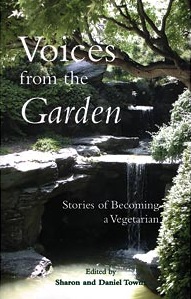 One day as I was sitting at the computer looking at the website of People for the Ethical Treatment of Animals (www.peta.org), my daughter Ashlee, age six, came up to me and said "Mom, what's that?" I began to describe exactly what the site was--how the organization thought people should be vegetarians so animals didn't have to die. We looked at the site together and decided that we would try and become vegetarians for the animals.
One day as I was sitting at the computer looking at the website of People for the Ethical Treatment of Animals (www.peta.org), my daughter Ashlee, age six, came up to me and said "Mom, what's that?" I began to describe exactly what the site was--how the organization thought people should be vegetarians so animals didn't have to die. We looked at the site together and decided that we would try and become vegetarians for the animals.
We went shopping and looked at what was out there for vegetarians. I explained to my children that they would have to sacrifice a lot, like McDonald's, jello, marshmallows, some candy, and much more. They didn't even have to think about it: "Mom, we will do it for the animals so they don't have to suffer." So we started making the transition. As of December 1, 1998 we had given up all meat and any products that have been tested on animals. We will not wear anything that contains animal by-products, such as leather.
My children sometimes feel the sacrifice when playing with other kids who get to go to all the fast food restaurants, but they never question what they have done. What they do question is why everyone doesn't become a vegetarian to save the animals. We drive by the cow pastures and they say, "Mommy, if everyone stopped eating meat these cows wouldn't have to die." I try and explain to them that, while we can't make everyone give up eating meat, by giving it up ourselves we have not only saved the lives of thousands of animals but we have saved rain forests and we have also saved the Earth from added stress.
The thing that amazes most people is that my children made the choice; I did not make them. They decided to do it on their own. Most adults can't make that sacrifice; that is why they try and justify their eating of animals, and have a hard time understanding why we do what we do.
The harshest criticism we encounter is from our own family. Family members seem to be so concerned that we are not getting enough protein or enough vitamins. It's funny, but I am concerned for them on the same issues. I am amazed that I lived as long as I did eating things that were so unhealthy for me. I thank goodness my kids were wise enough to get us all to change. Hopefully, I can do right by all my years of eating meat.
Eating out is harder and harder to do. For some reason people see it as a joke when you tell them you don't eat meat. I have a tendency not to say I am vegetarian because I have a feeling they want to make a fool of me. Maybe I am overly worried about it, but having seen the looks on people's faces when they hear I am vegetarian, it makes me realize that I must be careful with the words I use.
I think the best defense when people ask me why I am vegetarian is to let my children explain it. Opponents never seem to have an argument for the children. And how could they, when a seven-year-old says, "How can you eat dead animals?. . . . Animals have feelings too, you know. Animals shouldn't have to die just so we can eat. Have you ever tried veggie nuggets? No animals had to die, and they taste good!"
Reprinted from Voices From the Garden
(Slightly Altered)
Sharon and Daniel Towns, Eds.
Pioneer: Tom Regan, 1938 -
The Bird and the Cage, Part One

Philosopher/activist Tom Regan might be called a borderline figure--or a colossus--who has one foot among the "pioneers" and another among the "pilgrims." We at The Peaceable Table have set 1973 as the year separating these two categories, the year when the animal defense movement became really airborne in the United States. Regan's work is an important reason for its takeoff.
Tom Regan was born in Pittsburgh and raised in a working-class neighborhood on the North Side, amid busy and sooty but beloved streets. Had his family stayed there he would have gone to work right out of high school, and never given much thought to animals; but, against his will, his family moved to the suburbs. In this setting, where his friends' parents had all gone to college and his friends were expected to, he followed the crowd.
His academic college record was conspicuously undistinguished, but his interest in philosophy was awakened, and he chose it as his major. This awakening did not include any questioning of the status of animals; in fact he even spent one summer as apprentice in a butcher's shop, without feeling the slightest qualms at what was going on.
Having failed to find a job after graduating in 1960, Tom applied for admission to the University of Virginia to do graduate work in philosophy, and was (conditionally) accepted. Here, analyzing ethical concepts, he found his intellectual place. During this time also found his soul-mate Nancy, who has grown wih him and shared in his life's work. Early in their marriage the Regans adopted a poodle, Gleco, whom they loved passionately and who was later to provide a crucial catalyst in their spiritual development.
Tom took his Ph.D. in 1964 and began teaching moral philosophy in the same abstract way he had learned it. But he felt dissatisfied. The eruption of the Vietnamese war in 1965, the violence and death he saw on the television every evening, made him feel he was fiddling with words while Vietnam burned. He settled down to work at the concrete issue of the war. Was it justified? Is violence ever justified? As part of this search, he read many hundreds of pages of Gandhi. Though never completely converted to total ahimsa, Tom felt the pressure of Gandhi's imperative to minimize violence, including violence to animals. "The meat on my plate now had an accusatory voice."
But the voice did not gain compelling power until, in the summer of 1972, their much-beloved Gleco was killed by a car. The deep grief that both Regans felt at this loss compelled their awareness that if one dog was so precious, how can one justify subjecting other dogs--or any animals--to casual violence? "Wherever in the world there is life that feels, a being whose welfare can be affected by what we do (or fail to do), there love and compassion, justice and protection must find a home." They found that they were vegetarians, and Tom faced the challenge of articulating a firm philosophical ground for this conviction.
Also in 1973 a review, by an unknown Oxford philosopher, of an obscure anthology entitled Animals, Men and Morals: An Enquiry into the Maltreatment of Non-Humans, was published in The New York Review of Books. The review caused such an earthquake that the editors of the Review of Books asked Singer to develop his essay into a book, which he did. The book was Animal Liberation, and the author was Peter Singer. The two philosophers got together and made plans to collaborate. The rest, as they say, is history.
(To Be Continued)
--Summarized from "A Bird in the Cage" by Tom Regan
Poetry:
The Wild Duck
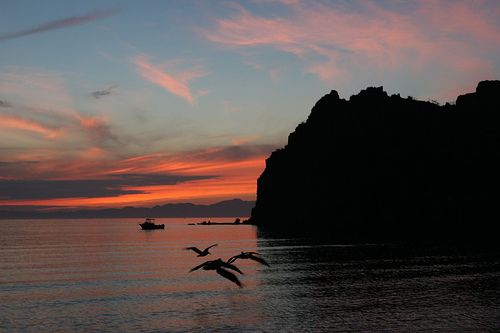
Twilight. Red in the West.
Dimness. A glow on the wood.
The teams plod home to rest.
The wild duck come to glean.
O souls not understood,
What a wild cry in the pool;
What things have the farm ducks seen
That they cry so--huddle and cry?
Only the soul that goes.
Eager. Eager. Flying.
Over the globe of the moon,
Over the wood that glows.
Wings linked. Necks a-strain,
A rush and a wild crying.
A cry of the long pain
In the reeds of a steel lagoon,
In a land that no man knows.
--John Masefield, 1878-1967
Credits:
The Peaceable Table is
intended to resume the witness of that excellent vehicle of the Friends
Vegetarian Society of North America, The Friendly
Vegetarian, which appeared quarterly between 1982 and
1995. Following its example, and sometimes borrowing from its
treasures, we publish articles for toe-in-the-water
vegetarians as well as long-term ones, poetry, letters, book
and film reviews, and recipes.
The journal is intended to be
interactive; contributions, including illustrations, are
invited for the next issue. Deadline for the February issue
will be January 29, 2007. Send to graciafay@mac.com
or 10 Krotona Hill, Ojai, CA 93023. We operate primarily
online in order to save trees and labor, but hard copy
is available for interested persons who are not online.
The latter are asked to donate $12 (USD) per year if their means allow. Other
donations to offset the cost of the domain name, server, and
advertising notices in other periodicals are welcomed.
Website www.vegetarianfriends.net
Editor: Gracia Fay Ellwood
Book and Film Reviewers: Benjamin Urrutia & Robert Ellwood
Recipe Editor: Angela Suarez
NewsNotes Contributors: Marian Hussenbux & Lorena Mucke
Technical Architect: Richard Scott Lancelot Ellwood
Sponsored by the Animal Kinship Committee
Orange Grove Friends Meeting, Pasadena, California


 Zookeepers have a peculiar role in the world of animal concerns. Theirs is a difficult, often thankless job, in which several highly diverse constituencies need to be satisfied, and in which missteps are often loudly publicized in the media by watchdog groups. On the one hand, the best of the zookeepers– among whom the authors of these two books must certainly be counted – are well-trained, motivated by a real love of animals frequently going back to childhood, and dedicated to doing the best they can both for the animals and for the educational and ecological roles they envision for zoos, in which they deeply believe. On the other hand, they are aware that a zoo environment, however well planned, can never be truly natural for the animals, and that they are subjecting them to stress and, too often, unnatural danger of disease or injury.
Zookeepers have a peculiar role in the world of animal concerns. Theirs is a difficult, often thankless job, in which several highly diverse constituencies need to be satisfied, and in which missteps are often loudly publicized in the media by watchdog groups. On the one hand, the best of the zookeepers– among whom the authors of these two books must certainly be counted – are well-trained, motivated by a real love of animals frequently going back to childhood, and dedicated to doing the best they can both for the animals and for the educational and ecological roles they envision for zoos, in which they deeply believe. On the other hand, they are aware that a zoo environment, however well planned, can never be truly natural for the animals, and that they are subjecting them to stress and, too often, unnatural danger of disease or injury. Phillip Robinson was director of veterinary medicine at the world-famous San Diego Zoo for ten years; he is now director of veterinary services at the University of California, San Diego. Understandably, his book gives more attention than the other to animal medical issues. Jeffrey P. Bonner is President (Director) of the also distinguished Saint Louis Zoo. Both are men clearly more used to making practical decisions in real-world situations where options are limited, and none of them perfect, than in dealing with philosophical issues regarding animals rights and welfare. At the same time they each have a vision of an ideal zoo, which, leaving far behind the animals-in-cages model, would provide its exhibits near-natural environments. It would be involved in conservation efforts, especially for endangered species, through maintaining gene pools and in field work around the world; it would make a real difference through its educational efforts.
Phillip Robinson was director of veterinary medicine at the world-famous San Diego Zoo for ten years; he is now director of veterinary services at the University of California, San Diego. Understandably, his book gives more attention than the other to animal medical issues. Jeffrey P. Bonner is President (Director) of the also distinguished Saint Louis Zoo. Both are men clearly more used to making practical decisions in real-world situations where options are limited, and none of them perfect, than in dealing with philosophical issues regarding animals rights and welfare. At the same time they each have a vision of an ideal zoo, which, leaving far behind the animals-in-cages model, would provide its exhibits near-natural environments. It would be involved in conservation efforts, especially for endangered species, through maintaining gene pools and in field work around the world; it would make a real difference through its educational efforts.
 The only other noteworthy animal figure is the computer-generated blue dragon into which Queen Narissa transforms herself, to be finally defeated by Giselle, who rescues Robert from her (literal) clutches. It is hard to speculate what effect this manifestly evil beast will have on children's attitudes toward animals. The positive effect of Pip and the clean-up crew might be undercut by an increased fear of large snakes; both effects might co-exist; or, more likely, the dragon will be too exotic to affect most children's feelings about animals at all.
The only other noteworthy animal figure is the computer-generated blue dragon into which Queen Narissa transforms herself, to be finally defeated by Giselle, who rescues Robert from her (literal) clutches. It is hard to speculate what effect this manifestly evil beast will have on children's attitudes toward animals. The positive effect of Pip and the clean-up crew might be undercut by an increased fear of large snakes; both effects might co-exist; or, more likely, the dragon will be too exotic to affect most children's feelings about animals at all. One day as I was sitting at the computer looking at the website of People for the Ethical Treatment of Animals (
One day as I was sitting at the computer looking at the website of People for the Ethical Treatment of Animals (
